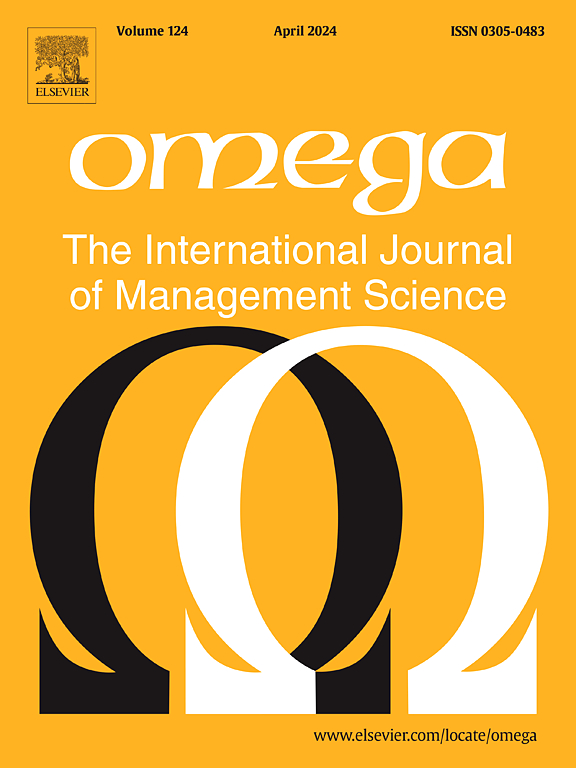分散合作生产系统中的理性决策与假定决策:解决方案和应用程序
IF 7.2
2区 管理学
Q1 MANAGEMENT
Omega-international Journal of Management Science
Pub Date : 2025-09-24
DOI:10.1016/j.omega.2025.103412
引用次数: 0
摘要
最近的研究考察了当系统产出是共同生产时,即产出取决于双方的努力时,两个独立的参与方的分散决策。在本文中,我们提出了一个通用的建模框架,以重新检查从这一研究流中获得的结果的鲁棒性。为了对分散合作生产系统中的决策过程进行建模,我们使用恒定替代弹性(CES)函数对双方共同生产的输出进行建模,并考虑同时移动和顺序移动博弈。我们还比较了理性企业的均衡努力和假设企业的最优努力。在这里,每个理性企业通过预测其他企业的理性决策来做出决策,而每个假定企业基于对其他企业决策的先验信念来做出决策。我们表明,同时移动和顺序移动游戏产生相似的结构结果。首先,每个理性(或假定)企业所付出的努力随着企业“努力投资回报”的增加而增加。第二,虽然假设企业的努力不是均衡的,但我们发现,当先验信念足够高而努力成本因素足够低时,这些非均衡的努力比理性企业的努力产生更高的回报。我们还应用这些结果来重新审视最近文献中获得的一些关键发现,这些文献中的合作生产模型可以被视为CES输出函数的特殊情况。我们发现,在一般的CES函数下,基于特殊情况的现有结果可能不成立。因此,我们的一般模型和结果提供了新的见解。最后,我们演示了如何将我们的一般模型应用于检查涉及两个具有自身利益的独立方的产品开发和能力规划决策所产生的其他设置。本文章由计算机程序翻译,如有差异,请以英文原文为准。
Rational versus presumptive decisions in a decentralized co-production system: Solutions and applications
Recent research has examined the decentralized decisions of two independent parties when the system output is co-produced, i.e., the output depends on the efforts exerted by both parties. In this paper, we present a general modeling framework to reexamine the robustness of the results obtained from this stream of research. To model the decision-making process in a decentralized co-production system, we use the Constant Elasticity of Substitution (CES) function to model the output co-produced from the two parties and consider both simultaneous-move and sequential-move games. We also compare the equilibrium efforts exerted by rational firms and the optimal efforts exerted by presumptive firms. Here, each rational firm makes decisions by anticipating the other firm’s rational decision, whereas each presumptive firm makes decisions based on a prior belief about the other firm’s decision. We show that both simultaneous-move and sequential-move games yield similar structural results. First, the effort exerted by each rational (or presumptive) firm increases with the firm’s “returns on effort investment”. Second, while the efforts exerted by presumptive firms are not in equilibrium, we find that these off-equilibrium efforts can result in higher payoffs than the efforts exerted by rational firms when the prior beliefs are sufficiently high and effort cost factors are sufficiently low. We also apply these results to reexamine some key findings obtained in the recent literature whose co-production model can be viewed as special cases of the CES output function. We find that the existing results based on the special case may not hold under the general CES functions. Hence, our general model and results provide new insights. Finally, we demonstrate how our general model can be applied to examine other settings arising from product development and capacity planning decisions involving two independent parties with self-interests.
求助全文
通过发布文献求助,成功后即可免费获取论文全文。
去求助
来源期刊

Omega-international Journal of Management Science
管理科学-运筹学与管理科学
CiteScore
13.80
自引率
11.60%
发文量
130
审稿时长
56 days
期刊介绍:
Omega reports on developments in management, including the latest research results and applications. Original contributions and review articles describe the state of the art in specific fields or functions of management, while there are shorter critical assessments of particular management techniques. Other features of the journal are the "Memoranda" section for short communications and "Feedback", a correspondence column. Omega is both stimulating reading and an important source for practising managers, specialists in management services, operational research workers and management scientists, management consultants, academics, students and research personnel throughout the world. The material published is of high quality and relevance, written in a manner which makes it accessible to all of this wide-ranging readership. Preference will be given to papers with implications to the practice of management. Submissions of purely theoretical papers are discouraged. The review of material for publication in the journal reflects this aim.
 求助内容:
求助内容: 应助结果提醒方式:
应助结果提醒方式:


